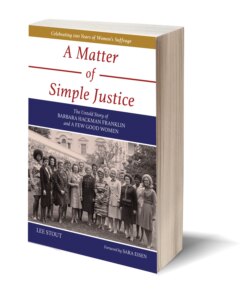Читать книгу A Matter of Simple Justice - Lee Stout - Страница 12
На сайте Литреса книга снята с продажи.
ОглавлениеINTRODUCTION
The Question and the Answer
At his February 6, 1969, news conference, President Richard M. Nixon announced details of his upcoming European trip and then proceeded to take questions. Near the end of the news conference, which was dominated largely by foreign and defense issues, Vera Glaser, of the North American Newspaper Alliance, rose and asked, “Mr. President, in staffing your administration, you have so far made about 200 high-level Cabinet and other policy position appointments, and of these only three have gone to women. Can you tell us, sir, whether we can expect a more equitable recognition of women’s abilities, or are we going to remain a lost sex?”1
The president, in only his second formal press conference, seventeen days after the inauguration, “rolled his eyes upward for a moment in a kind of sighing chagrin,” as one reporter put it.2 He then smiled at Vera Glaser and quipped, “Would you be interested in coming into the Government?” There was some laughter, but apparently realizing that the issue, and the television audience, deserved more, he quickly added, “Very seriously, I had not known that only three had gone to women, and I shall see that we correct that imbalance very promptly.”3
Vera Glaser later recalled, “I had qualms as a journalist about asking the President the kind of question that I did. And yet in simple justice, you had to ask it.”4
Like the rest of the women interviewed for the “A Few Good Women” project, Vera Glaser was not afraid to stand up and say what needed to be said. As she later told the Citizens’ Advisory Council on the Status of Women, this was “a movement to achieve a fair share of the nation’s economic rewards and political leadership—a share to which our numbers, our education, our training, and our capacities as human beings fully entitle us.”5
Massive changes in American society, such as the women’s movement, are woven together from many historical threads. The people, events, and activities this work discusses are but one part of that process. However, their part has largely been forgotten. By capturing these memories in oral history, I have tried to rescue an overlooked but important aspect of those developments. Vera Glaser was just one catalyst for this change; she was not alone.
FIGURE 1
President Nixon’s second press conference, on February 6, 1969, at which Vera Glaser asked “The Question.” White House Photograph files, Richard Nixon Presidential Library and Museum.
Barbara Hackman Franklin became the key White House figure in recruiting women for executive positions in the federal government in the administration of Richard M. Nixon. In her two years as staff assistant to the president, she was responsible for recruiting more than three times as many women executives for the government as in any previous administration. The story of these “few, good women” is to a great extent her story as well. Thus, this book is organized in two parts: the first provides a narrative overview of the evolution of the “women’s program” and Barbara Franklin’s leadership of it, the second tells us more about those “few good women” as they speak out on a variety of topics including their backgrounds, recruitment, and experiences in government.
But before we turn to the Nixon administration and the remarkable experiences Barbara Franklin had there, we should consider several historical threads that led us to that significant but little known early point in President Nixon’s first term.
